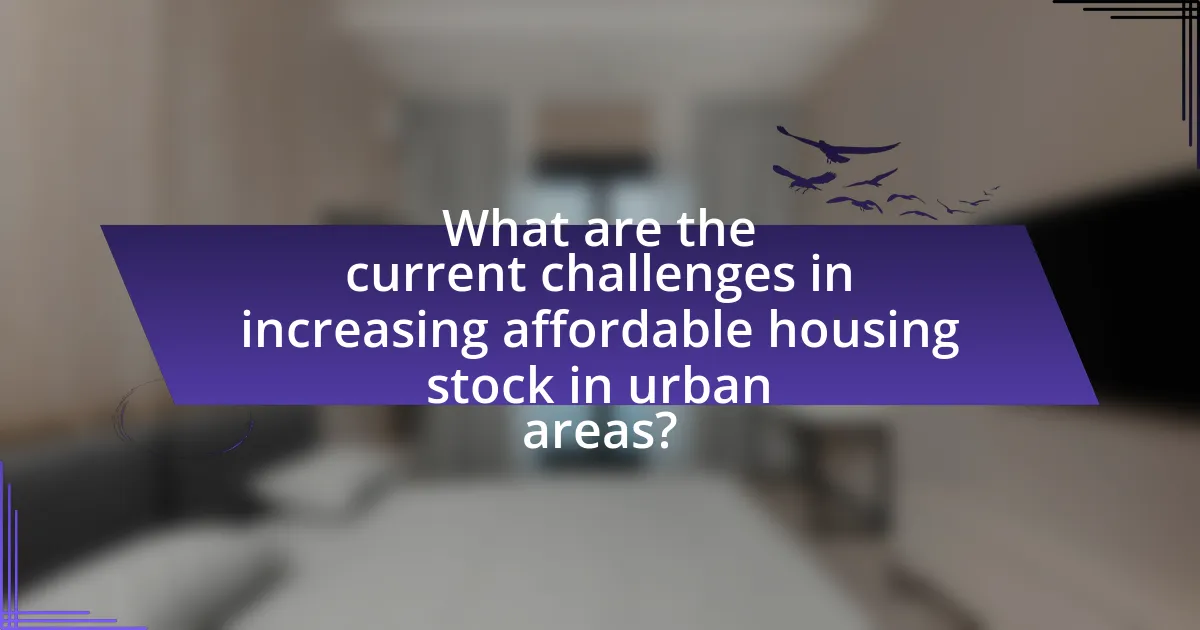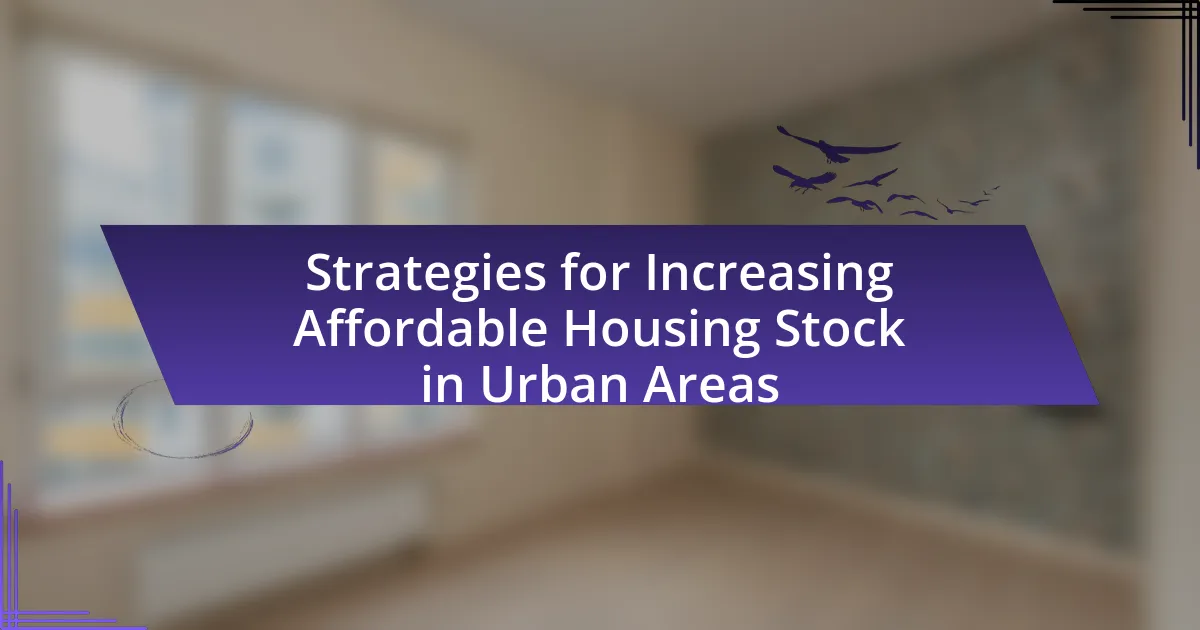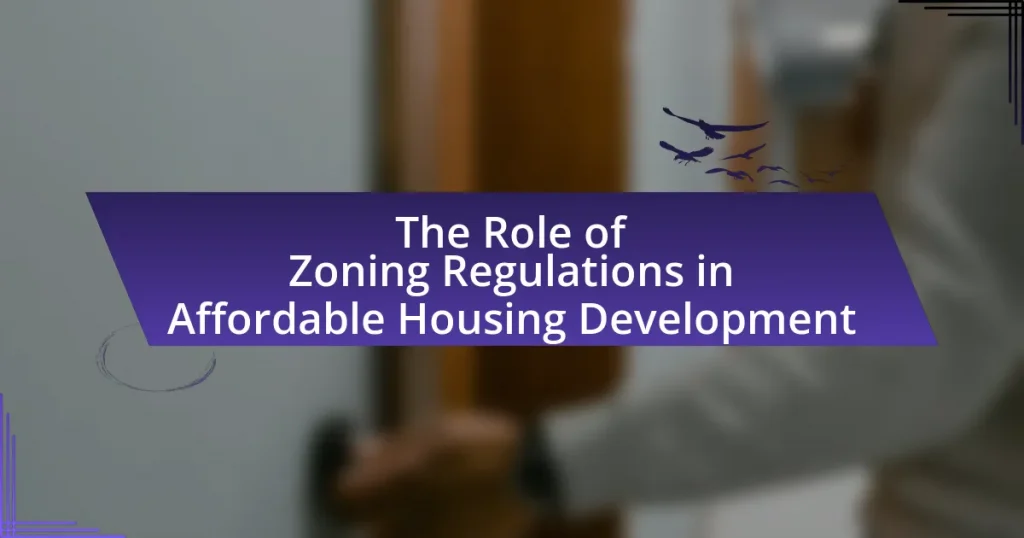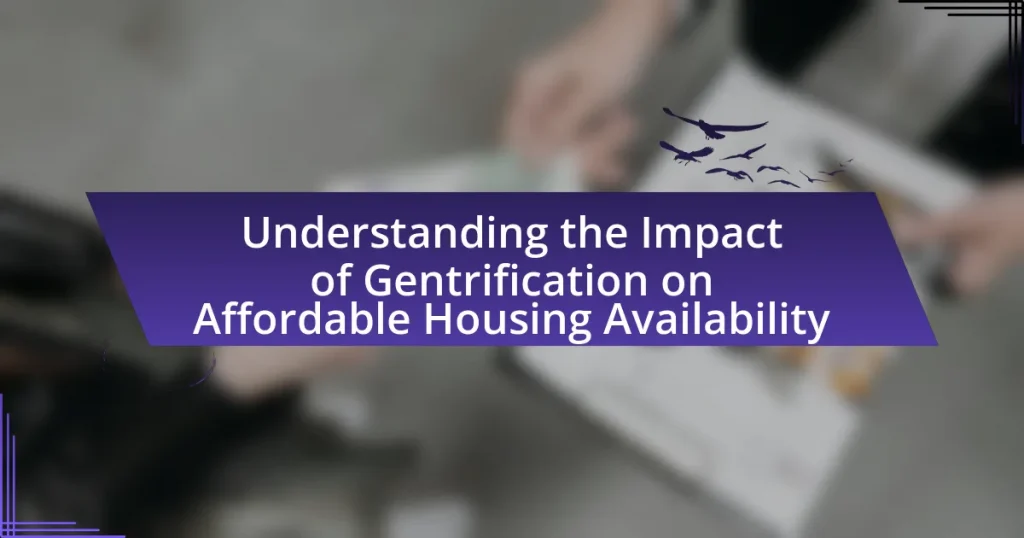The article focuses on strategies for increasing affordable housing stock in urban areas, addressing the current challenges such as high land costs, regulatory barriers, and insufficient funding. It examines the influence of economic factors, income inequality, and rising construction costs on housing availability. Additionally, the article discusses the impact of zoning laws, community opposition, and the importance of public-private partnerships in enhancing affordable housing development. It also highlights effective government policies, innovative construction methods, and best practices for successful affordable housing projects, emphasizing the need for community engagement and sustainable practices to ensure long-term viability.

What are the current challenges in increasing affordable housing stock in urban areas?
The current challenges in increasing affordable housing stock in urban areas include high land costs, regulatory barriers, and insufficient funding. High land costs in urban centers often make it economically unfeasible for developers to build affordable units, as the return on investment is lower compared to luxury developments. Regulatory barriers, such as zoning laws and lengthy permitting processes, can delay projects and increase costs, further discouraging the construction of affordable housing. Additionally, insufficient funding from both public and private sectors limits the ability to finance new affordable housing projects, exacerbating the housing crisis. According to the National Low Income Housing Coalition, there is a shortage of 7 million affordable rental homes for extremely low-income renters, highlighting the urgency of addressing these challenges.
How do economic factors influence affordable housing availability?
Economic factors significantly influence affordable housing availability by affecting both the supply and demand dynamics in the housing market. For instance, rising construction costs due to increased prices for materials and labor can limit the ability of developers to build affordable housing units. According to the National Association of Home Builders, the cost of building materials has increased by over 30% in recent years, directly impacting the feasibility of affordable housing projects. Additionally, economic conditions such as unemployment rates and income levels determine the purchasing power of potential buyers or renters, which in turn influences demand for affordable housing. A report from the U.S. Department of Housing and Urban Development indicates that areas with higher unemployment rates often experience a decrease in affordable housing availability, as fewer individuals can afford rent or mortgages. Thus, economic factors play a crucial role in shaping the landscape of affordable housing.
What role does income inequality play in housing affordability?
Income inequality significantly impacts housing affordability by creating disparities in income levels that limit access to affordable housing options. As income inequality rises, a larger portion of the population struggles to afford housing, leading to increased demand for lower-cost housing while simultaneously driving up prices in more affluent areas. For instance, a report from the Joint Center for Housing Studies at Harvard University indicates that households in the lowest income brackets face severe housing cost burdens, spending more than 30% of their income on housing, which is considered unaffordable. This situation exacerbates the housing crisis, as those with lower incomes are often forced into substandard living conditions or are priced out of the market entirely.
How do rising construction costs impact affordable housing projects?
Rising construction costs significantly hinder affordable housing projects by increasing the overall financial burden on developers and limiting the number of units that can be built within budget constraints. As construction expenses escalate, developers may reduce the scale of projects, opt for lower-quality materials, or abandon affordable housing initiatives altogether, leading to a decrease in available affordable units. According to the National Association of Home Builders, construction costs have risen by over 30% in the past few years, directly impacting the feasibility of new affordable housing developments. This trend exacerbates the housing crisis, as fewer affordable options become available to low-income families, further widening the gap between housing demand and supply.
What regulatory barriers exist for affordable housing development?
Regulatory barriers for affordable housing development include zoning restrictions, lengthy permitting processes, and building codes that may not accommodate cost-effective construction methods. Zoning laws often limit the density and types of housing that can be built, which restricts the supply of affordable units. For instance, many urban areas have single-family zoning that prevents the development of multi-family housing, thereby limiting options for affordable living. Additionally, the permitting process can take months or even years, delaying projects and increasing costs, which ultimately affects affordability. Building codes may also impose requirements that elevate construction costs, making it financially unfeasible to develop affordable housing. These barriers collectively hinder the ability to increase the stock of affordable housing in urban areas.
How do zoning laws affect the construction of affordable housing?
Zoning laws significantly influence the construction of affordable housing by dictating land use, density, and building types. These regulations can restrict the development of high-density housing, which is often necessary for creating affordable units, by imposing minimum lot sizes or prohibiting multi-family dwellings. For instance, a study by the National Multifamily Housing Council found that restrictive zoning can increase housing costs by limiting supply, thereby exacerbating affordability issues. Additionally, zoning laws may require costly infrastructure improvements or impose lengthy approval processes, further hindering the timely development of affordable housing projects.
What are the implications of building codes on housing costs?
Building codes significantly impact housing costs by imposing regulations that can increase construction expenses. These codes often require specific materials, design standards, and safety measures, which can lead to higher upfront costs for developers. For instance, a study by the National Association of Home Builders found that building codes can add an average of 25% to the cost of new homes due to compliance with energy efficiency and safety standards. Consequently, these increased costs are typically passed on to homebuyers, making housing less affordable.
How does community opposition affect affordable housing initiatives?
Community opposition significantly hinders affordable housing initiatives by creating barriers to development approval and increasing project costs. When local residents express concerns about potential negative impacts, such as changes in neighborhood character or increased traffic, these objections can lead to lengthy public hearings and delays in the permitting process. For instance, a study by the Urban Institute found that community opposition can result in a 20% increase in the time it takes to secure necessary approvals for affordable housing projects. This opposition often leads to developers needing to invest more resources in community engagement and modifications to project plans, which can ultimately deter investment in affordable housing.
What are the common concerns of communities regarding affordable housing?
Communities commonly express concerns about affordable housing related to increased density, potential impacts on property values, and the adequacy of infrastructure. Increased density can lead to overcrowding and strain on local resources, which residents fear may diminish their quality of life. Additionally, many community members worry that the introduction of affordable housing may negatively affect property values, as evidenced by studies indicating that perceptions of neighborhood desirability can shift with new developments. Furthermore, concerns about whether existing infrastructure, such as schools, transportation, and public services, can accommodate new residents are prevalent, with data showing that inadequate infrastructure can lead to community dissatisfaction and increased traffic congestion.
How can community engagement improve acceptance of affordable housing projects?
Community engagement can significantly improve acceptance of affordable housing projects by fostering trust and collaboration between developers and local residents. When community members are actively involved in the planning process, they are more likely to feel a sense of ownership and investment in the project. This involvement can lead to the identification of local needs and preferences, which can be integrated into the project design, making it more appealing to the community.
Research indicates that projects with strong community engagement efforts often experience fewer objections and greater support. For instance, a study by the Urban Institute found that inclusive planning processes can reduce opposition by up to 30%, as residents feel their voices are heard and their concerns addressed. By prioritizing transparency and communication, developers can mitigate fears and misconceptions about affordable housing, ultimately leading to higher acceptance rates.

What strategies can be implemented to increase affordable housing stock?
To increase affordable housing stock, municipalities can implement inclusionary zoning policies that require a percentage of new developments to be affordable for low- and moderate-income households. This strategy has been successfully adopted in cities like San Francisco, where inclusionary zoning has led to the creation of thousands of affordable units. Additionally, governments can provide financial incentives, such as tax credits or grants, to developers who commit to building affordable housing. For instance, the Low-Income Housing Tax Credit program in the United States has facilitated the construction of over 3 million affordable housing units since its inception in 1986. Furthermore, streamlining the permitting process can reduce costs and time for developers, encouraging them to invest in affordable housing projects. Evidence from various urban studies indicates that reducing bureaucratic hurdles can significantly increase the rate of affordable housing development.
How can public-private partnerships enhance affordable housing development?
Public-private partnerships (PPPs) can enhance affordable housing development by leveraging the strengths of both sectors to increase funding, efficiency, and innovation. These collaborations allow public entities to access private capital and expertise, which can accelerate project timelines and reduce costs. For instance, a study by the Urban Institute found that PPPs can lead to a 20-30% reduction in construction costs due to shared resources and risk mitigation strategies. Additionally, PPPs can facilitate the development of mixed-income communities, which promote social integration and economic diversity, further contributing to the overall goal of increasing affordable housing stock in urban areas.
What are the benefits of collaboration between government and private developers?
Collaboration between government and private developers enhances the efficiency and effectiveness of affordable housing initiatives. This partnership allows for the pooling of resources, expertise, and funding, which can lead to the rapid development of housing projects that meet community needs. For instance, government incentives such as tax credits and zoning allowances can motivate private developers to invest in affordable housing, resulting in increased housing stock. According to the National Low Income Housing Coalition, public-private partnerships have successfully produced thousands of affordable units across various urban areas, demonstrating the tangible benefits of such collaborations.
How can funding from private entities support affordable housing initiatives?
Funding from private entities can significantly support affordable housing initiatives by providing essential capital for development projects. This financial backing enables developers to construct or rehabilitate housing units that are priced within reach of low- and moderate-income families. For instance, private investments can cover construction costs, reduce reliance on government funding, and expedite project timelines. According to the National Low Income Housing Coalition, private funding sources, including banks and investment firms, have increasingly participated in affordable housing through tax credit programs, such as the Low-Income Housing Tax Credit (LIHTC), which incentivizes private investment in affordable housing projects. This collaboration not only enhances the availability of affordable units but also stimulates local economies by creating jobs and increasing property values in urban areas.
What role does government policy play in promoting affordable housing?
Government policy plays a crucial role in promoting affordable housing by establishing regulations, funding mechanisms, and incentives that facilitate the development and preservation of affordable units. Policies such as zoning laws can encourage higher-density housing, while funding programs like the Low-Income Housing Tax Credit provide financial support to developers. Additionally, government initiatives often include direct subsidies for low-income families, which can increase their access to affordable housing options. For instance, the National Low Income Housing Coalition reports that in 2021, only 37 affordable and available rental homes existed for every 100 extremely low-income renter households, highlighting the need for effective government intervention to address this gap.
How can tax incentives encourage the development of affordable housing?
Tax incentives can encourage the development of affordable housing by reducing the financial burden on developers, making projects more economically viable. These incentives, such as tax credits, deductions, or exemptions, lower the overall costs associated with construction and operation, thus attracting more investment in affordable housing projects. For instance, the Low-Income Housing Tax Credit (LIHTC) program in the United States has successfully facilitated the creation of over 3 million affordable housing units since its inception in 1986, demonstrating the effectiveness of such incentives in stimulating development.
What policies have proven effective in other urban areas?
Policies that have proven effective in increasing affordable housing stock in urban areas include inclusionary zoning, which mandates that a percentage of new developments be affordable for low- and moderate-income residents. For example, San Francisco’s inclusionary housing program has resulted in thousands of affordable units being built since its inception. Additionally, community land trusts have been successful in cities like Burlington, Vermont, where they maintain long-term affordability by removing land from the speculative market. Furthermore, tax incentives for developers who build affordable housing, as seen in New York City’s 421-a program, have also led to significant increases in affordable units. These policies demonstrate measurable success in addressing housing shortages and promoting affordability in urban settings.
How can innovative construction methods contribute to affordable housing?
Innovative construction methods can significantly contribute to affordable housing by reducing costs and construction time. Techniques such as modular construction, 3D printing, and prefabrication streamline the building process, allowing for faster assembly and lower labor costs. For instance, a study by the McKinsey Global Institute found that modular construction can reduce project timelines by up to 50% and costs by 20%. Additionally, these methods often utilize sustainable materials and technologies, which can further decrease long-term operational costs for residents. By enhancing efficiency and minimizing waste, innovative construction methods create more opportunities for developers to offer affordable housing options in urban areas.
What are the advantages of modular and prefabricated housing?
Modular and prefabricated housing offers several advantages, including reduced construction time, cost efficiency, and sustainability. These housing types can be built in a factory setting, which allows for faster assembly on-site, often reducing construction time by 30-50% compared to traditional methods. Cost efficiency is achieved through economies of scale and reduced labor costs, with studies indicating that modular homes can be 10-20% cheaper than conventional homes. Additionally, modular and prefabricated housing often utilizes sustainable materials and practices, contributing to lower energy consumption and waste during construction. This combination of benefits makes modular and prefabricated housing a viable strategy for increasing affordable housing stock in urban areas.
How can sustainable building practices reduce costs in affordable housing?
Sustainable building practices can reduce costs in affordable housing by minimizing energy consumption and lowering long-term operational expenses. For instance, using energy-efficient materials and technologies can lead to significant savings on utility bills, with studies indicating that energy-efficient homes can save homeowners up to 30% on energy costs annually. Additionally, sustainable practices often involve lower maintenance costs due to the durability of eco-friendly materials, which can last longer than conventional options. Furthermore, government incentives and tax credits for sustainable construction can decrease initial investment costs, making affordable housing projects more financially viable.

What best practices can be adopted for successful affordable housing projects?
Successful affordable housing projects can be achieved by implementing community engagement, leveraging public-private partnerships, and ensuring sustainable design practices. Community engagement fosters local support and input, which can lead to projects that meet the specific needs of residents. Public-private partnerships can provide necessary funding and resources, as evidenced by the success of initiatives like the Low-Income Housing Tax Credit program, which has facilitated the creation of over 3 million affordable housing units in the United States since its inception. Sustainable design practices, such as energy-efficient building materials and designs, not only reduce long-term costs for residents but also contribute to environmental sustainability, aligning with modern urban development goals.
How can effective community involvement shape affordable housing projects?
Effective community involvement can significantly shape affordable housing projects by ensuring that the developments meet the actual needs and preferences of the residents. When community members actively participate in the planning and decision-making processes, they provide valuable insights into local housing demands, cultural considerations, and potential challenges, which can lead to more tailored and sustainable housing solutions. For instance, studies have shown that projects with strong community engagement tend to have higher rates of acceptance and lower instances of opposition, as seen in the case of the East Lake Community in Atlanta, where resident input led to a successful redevelopment that included affordable housing alongside amenities that served the community’s needs. This collaborative approach not only enhances the relevance of the housing projects but also fosters a sense of ownership and responsibility among residents, ultimately contributing to the long-term success and viability of affordable housing initiatives.
What strategies can be used to engage local residents in the planning process?
To engage local residents in the planning process, strategies such as community workshops, surveys, and participatory budgeting can be effectively utilized. Community workshops allow residents to voice their opinions and contribute ideas directly, fostering a sense of ownership in the planning outcomes. Surveys can gather broader input from the community, ensuring diverse perspectives are considered in decision-making. Participatory budgeting empowers residents by allowing them to allocate a portion of the budget to projects they prioritize, enhancing their involvement and investment in local development. These strategies have been shown to increase community buy-in and improve the relevance of planning initiatives, as evidenced by case studies in urban planning where resident engagement led to more successful project implementations.
How can feedback from the community improve project outcomes?
Feedback from the community can significantly improve project outcomes by ensuring that the needs and preferences of residents are accurately addressed. Engaging with community members allows project developers to gather insights on local issues, preferences, and potential obstacles, which can lead to more effective and tailored solutions. For instance, a study by the Urban Institute found that community engagement in housing projects resulted in a 30% increase in resident satisfaction and a 25% reduction in project delays, demonstrating that incorporating community feedback directly correlates with enhanced project success.
What are the key metrics for measuring the success of affordable housing initiatives?
Key metrics for measuring the success of affordable housing initiatives include affordability, occupancy rates, and resident satisfaction. Affordability is typically assessed by the percentage of income that residents spend on housing, with successful initiatives aiming for costs below 30% of household income. Occupancy rates indicate the effectiveness of the initiative in attracting residents, with higher rates suggesting successful demand and utilization of the housing stock. Resident satisfaction is measured through surveys and feedback, reflecting the quality of living conditions and community engagement. These metrics provide a comprehensive view of the initiative’s impact on the community and its alignment with housing goals.
How can occupancy rates indicate the effectiveness of affordable housing projects?
Occupancy rates serve as a key indicator of the effectiveness of affordable housing projects by reflecting the demand and utilization of available units. High occupancy rates suggest that the housing is meeting the needs of the community, indicating successful project implementation and affordability. For instance, a study by the Urban Institute found that affordable housing developments with occupancy rates above 90% are often viewed as successful, as they demonstrate that residents are able to secure housing within their financial means. Conversely, low occupancy rates may signal issues such as inadequate marketing, poor location, or unmet community needs, thereby highlighting areas for improvement in project design and execution.
What role does resident satisfaction play in evaluating housing success?
Resident satisfaction is a critical indicator of housing success, as it directly reflects the quality of living conditions and the effectiveness of housing policies. High levels of resident satisfaction often correlate with lower vacancy rates and increased community stability, which are essential for sustainable urban development. Studies have shown that satisfied residents are more likely to engage in community activities and advocate for local improvements, thereby enhancing the overall neighborhood environment. For instance, research conducted by the Urban Institute indicates that neighborhoods with higher resident satisfaction experience a 20% increase in community participation, which contributes to the long-term success of housing initiatives.
What practical steps can stakeholders take to ensure long-term sustainability of affordable housing?
Stakeholders can ensure long-term sustainability of affordable housing by implementing policies that promote mixed-income developments, securing ongoing funding for maintenance, and fostering community engagement. Mixed-income developments create diverse communities, which can stabilize property values and reduce reliance on public subsidies. Ongoing funding for maintenance is crucial; studies show that properties with regular upkeep retain their affordability and quality over time. Community engagement ensures that the needs of residents are met, leading to higher satisfaction and lower turnover rates, which contributes to the stability of affordable housing initiatives.



